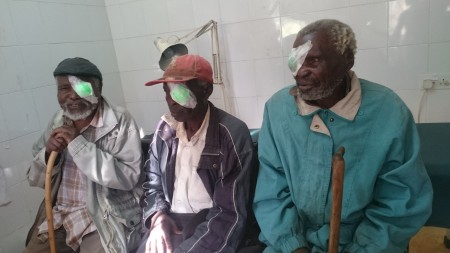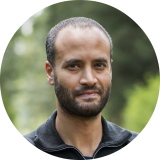
Participants in cataract surgery in Kenya
Credit: Peek Vision
by Dr Andrew Bastawrous, Peek Vision CEO and Associate Professor of International Eye Health at the International Centre for Eye Health (ICEH)
Today there are more than one billion people worldwide who cannot see well but could with the right treatment. Most of them only need a pair of glasses or a ten-minute cataract operation, one of the most cost-effective surgical procedures that exists.
This is not okay.
The huge statistics can sometimes be hard to comprehend. But for the individuals affected the consequences are very real.
John’s story
I met John on the outskirts of a small Kenyan town where we were running an eye clinic and testing some of the early components of Peek. He had already lost the vision in his right eye years earlier then gradually lost the vision in the left eye due to cataract.
John had become isolated and afraid to leave his home. He felt he had become a burden to his family and rarely spoke. Yet he was not aware that his slight loss was completely treatable; he had accepted that he would die blind and didn’t know he could regain his sight with a ten-minute operation.
Across the world, there are millions of people like John who are very difficult to find for the eye health providers who could help transform their vision. Most live in low- and middle-income countries where eye health resources are already under huge pressure, compounding the problem.
The challenge to eye health services
While eye health services are working around the clock to find and treat as many people as possible, the challenge is that people like John are effectively invisible and don’t usually appear in eye health service statistics. Typically, reports show the number of people screened or treated, but we rarely see the numbers that reveal who is being left behind. That in turn can make it difficult for eye health services to allocate scarce resources efficiently and ensure that hard-pressed specialist services are accessed by those who most need them.
2020 was a landmark year for the eye health sector and it is astonishing how much progress the sector has made in the last three decades. However, despite these impressive gains, the number of people affected by avoidable vision loss is growing and the same marginalised and vulnerable populations – including older people, women, children and people with disabilities – still risk being left behind.
Better data for continuous improvement
Peek and our partners want to change this. Our tools help eye health services understand the eye health needs of the populations they serve. That means they can determine who is missing out and what is stopping them from having their vision restored. Because the data is collected and tracked in real-time, eye health providers can adopt a process of continuous improvement, rather than having to wait for months or even years to collate paper-based records.
In the last year, despite all the challenges presented by the COVID-19 pandemic, we have seen how powerful this continuous improvement approach can be, thanks to the efforts of our incredible partners.
To give just one example, in Pakistan our partners CBM International have worked with the College of Ophthalmology & Vision Sciences (COAVS) and Sindh Institute of Ophthalmology & Visual Sciences (SIOVS) to implement Peek tools in several community and school eye health programmes. The results have been impressive. Despite eye health programmes temporarily closing in April due to COVID-19, in the last year the team have screened a huge number of people in the community and greatly improved the proportion of people attending hospital appointments. They have also used the data they gathered to address gender imbalances and improve the way primary and secondary health facilities are used.
Where next?
The successes in Pakistan and other programmes using Peek show what can – and needs to – be done, even in the uniquely challenging circumstances of the last year. As our partnerships grow and we are seeing activity restart after the problems caused by COVID-19, we know that many eye health services have huge backlogs. Unfortunately, the result is that a lot of people like John are now even further out of reach.
For John, he had given up hope. It was the wonderful care and time he received from the field team that made the difference. The morning after his surgery, John’s eye patch was removed and he stood in the open air with the sun on his face, “I feel so happy and that my old age has gone,” he said, smiling.
2020 was a dark and difficult year for many of us but there is hope. We have an opportunity to build back more equitable systems, so that John and the millions of people like him are no longer left behind.
I am looking forward to 2021 with huge gratitude to our incredible partners and supporters. I’m excited about the new opportunities we have to tackle the vision crisis. Together, we will continue working to bring better vision and health to everyone.

About the author: Dr Andrew Bastawrous is CEO and co-Founder of Peek Vision, and Associate Professor of International Eye Health at the International Centre for Eye Health at London School of Hygiene & Tropical Medicine. He has worked and undertaken research in over twenty countries, including two years living in Kenya where he led a major eye disease study and the development and testing of Peek.